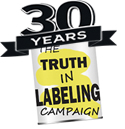MSG
Manufactured vs Natural Glutamic Acid
Ingredient Names Used to Hide MfG

What does it take to cause an adverse reaction?
MSG-sensitive people report reactions ranging from simple skin rash to severe depression and life-threatening physical conditions. Two or more reactions occurring together, or one following another, are not uncommon. The amount of processed free glutamic acid (MfG) ingested may play a role in the severity and specific nature of a reaction. MfG is the brain-damaging component of monosodium glutamate (MSG). It is found today in all flavor enhancers and a variety of fake proteins and protein substitutes.Some women report variations in their reactions at different times in their menstrual cycles. The intensity or severity of a reaction also appears to be affected by alcohol ingestion and/or exercise just prior to, or immediately following MfG ingestion. An athlete might routinely use protein powders that contain MfG without noticing any adverse effects, yet the same athlete might experience a heart irregularity leading to cardiac arrest when playing hard in a game after consuming a protein drink or another MfG-containing drink.
An adverse reaction is an unpleasant reaction that can be seen or felt by the affected person or an observer. Skin rash, nausea, migraine headache, heart irregularities, asthma, seizures, and depression are examples of adverse reactions that have been reported following ingestion of MfG. Each is a visible or observable reaction. When caused by MfG, each reaction can be traced back to recent exposure to MfG.
People vary in their reactions to MfG -- both in the amount of MfG needed to cause an adverse reaction and in the type of reaction experienced. We know that some people react to what would seem to be incredibly small amounts of MfG (the amount in a binder of a mineral supplement, for example), while others react only when they ingest considerably more. Some people will react to a meal cooked with monosodium glutamate and served with soy sauce, but will not react to lesser amounts of MfG found in some dairy products. Some MSG-sensitive people will react to the binders and fillers used in vitamin and mineral supplements made into tablets.
The adverse effects of MfG ingestion may be cumulative. People have reported eating products containing small amounts of MfG once a week without experiencing reactions, but report having had reactions when those same products were consumed two or three days in a row. In one well done 2002 study, no retinal damage was observed when MfG was fed to laboratory animals for a short period of time (a month), but as the time during which MfG was fed to those animals increased to 3 months and 6 months, there was observable damage (1).
It has been suggested that while a dose of MfG below a person's tolerance level may not produce an observable adverse reaction the first time MfG is ingested, it stimulates or damages vulnerable glutamate receptors, making them more sensitive to subsequent ingestion of MfG. That would explain why the same amount of MfG ingested at a later time or on a second day might, that second time, cause an observable reaction that was not seen before. Think of a subliminal dose of MfG as a drill with a dull bit being used on a piece of hard wood. The first time the drill is applied, you make a dent in the board you are working on, but you don't make a hole (a reaction). The second time the drill is applied, you either make a larger dent or actually make a hole (a reaction).
The work of Dr. Peter Spencer (2-4) and others has suggested that glutamic acid may act as a "slow neurotoxin," not resulting in observable damage such as dementia until years after the MfG is ingested. Mercury, for example, is a slow neurotoxin -- manifesting its toxic effects years after being ingested. It is entirely possible that the concept of a "slow neurotoxin" may be relevant to the production of human adverse reactions to MfG.
We have focused here on adverse reactions. We would be remiss, however, if we ignored the role that MfG plays in causing brain damage, endocrine disorders, behavior disorders, and neurodegenerative disease. The unborn and the very young are most vulnerable to brain damage and its subsequent endocrine and behavior disorders, for the immature blood brain barrier does not protect the hypothalamus from the neurotoxicity of the three neurotoxic amino acids used in processed foods: glutamic acid, aspartic acid, and l-cysteine.
The vulnerable brains of the unborn will be damaged when pregnant women pass ingested MfG to their fetuses. Olney first described that phenomenon in 1969, observing that the MSG inflicted brain damage to the arcuate nucleus of the hypothalamus was followed by gross obesity, reproductive disfunction including infertility, and behavior disorders (5). The relevance of human obesity to Olney’s work is evidenced by the onset of what is now called “the obesity epidemic,” which manifested after 1957, when virtually unlimited amounts of MfG because available, accessible and widely used in processed and ultra-processed food.
At the other end of the spectrum lie the elderly, whose blood brain barriers will have been diminished by fever, stroke, trauma to the head, seizures, ingestion of monosodium glutamate, and the normal process of aging (6,7).
REFERENCES
1. Ohguro et al. A high dietary intake of sodium glutamate as flavoring (Ajinomoto) causes gross changes in retinal morphology and function. Experimental Eye Research. 2002;75(3):307-315. PMID: 123840932. Long-latency neurodegenerative disease in the western Pacific. Geriatrics. 1991 Aug;46 Suppl 1:37-42. PMID: 1894143
3. Spencer PS, Kisby GE, Ludolph AC. Slow toxins, biologic markers, and long-latency neurodegenerative disease in the western Pacific region. Neurology. 1991 May;41(5 Suppl 2):62-6; discussion 66-8. PMID: 2041595
4. Spencer PS. Guam ALS/parkinsonism-dementia: a long-latency neurotoxic disorder caused by "slow toxin(s)" in food? Can J Neurol Sci. 1987 Aug;14(3 Suppl):347-57. PMID: 3315142
5. Olney JW. Brain lesions, obesity, and other disturbances in mice treated with monosodium glutamate. Science. 1969 May 9;164(3880):719-21. doi: 10.1126/science.164.3880.719. PMID: 5778021.
6. Blaylock RL. (1994) Excitotoxins: The taste that kills. Santa Fe, NM: Health Press.
7. Nemeroff CB, Crisley FD. (1975) Monosodium L-glutamate induced convulsions: temporary alteration in blood-brain barrier permeability to plasma proteins. Environ Physiol Biochem 5, 389-395.

